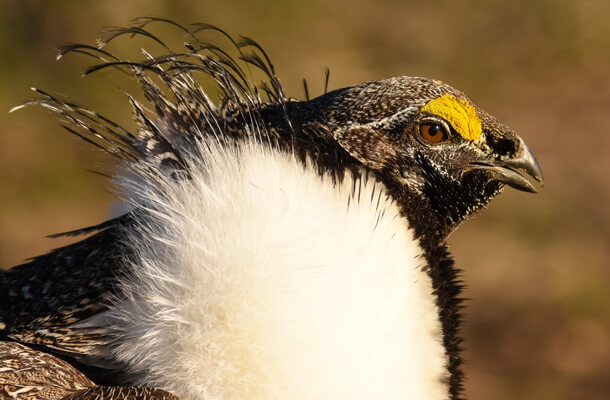Grouse Plan Revisions Risk Endangering the Species
Contact: Steve Holmer, VP of Policy, 202-888-7490; Jennifer Howard, Director of Public Relations, 202-888-7472
(Washington, D.C., Aug. 7, 2017) Conservation of one of the nation's fastest-disappearing birds took a step back today when the U.S. Department of the Interior ordered revisions to Greater Sage-Grouse management plans, opening the door to expanded development across the American West. (Interior's statement is available here.)

Revisions to existing management plans threaten Greater Sage-Grouse. Photo by cjhiker/Shutterstock
"Habitat protection for the grouse is already at a minimum level based on the plans put in place just two years ago,” said Steve Holmer, Vice President of Policy at American Bird Conservancy. “Weakening these plans puts the grouse at grave risk of further population declines.”
In addition to one of the West's most iconic species, more than 350 species of other High Plains birds and wildlife—and even the Western way of life—are also at stake.
“The Greater Sage-Grouse is an amazing bird, but this is about more than saving a single species,” Holmer said. “It is a choice between two different visions for the American West. Do we want a truly wild West—an inspiring landscape with wide-open rangelands, big skies, and stunning vistas—or an industrial landscape littered with oil rigs and mining pits?”
The existing grouse conservation plans were finalized in 2015 after five years of collaborative effort by stakeholders across the West. The plans are designed to halt the loss of sage grouse habitat and to balance conservation with limited oil and gas drilling, mining, and renewable energy development. They also include safeguards for adaptive management and mitigation should grouse populations continue to decline, bolstering the decision not to list the Greater Sage-Grouse under the Endangered Species Act.
“Sportsmen, business owners, Western elected officials, and conservationists all invested years of work and countless resources into developing the existing plans,” said Holmer. “Now, we're all speaking with a common message: Give the grouse management plans a chance to work.”
The Wyoming legislature approved a measure in February to begin a captive-breeding program, an idea that has been embraced by the Department of the Interior. Top grouse researcher John Connolly and other experts argue that this is not a viable conservation strategy.
“Captive breeding is not going to recover sage grouse populations and may end up spreading disease or harming the genetics of wild grouse,” said Holmer. “A similar breeding effort for Northern Bobwhite has not reversed quail declines.”
Ready to take action for the Greater Sage-Grouse? Tell Interior Secretary Ryan Zinke, along with your U.S. Representative and Senators, that you are opposed to weakening conservation measures for this iconic species of the American West.
###
American Bird Conservancy is dedicated to conserving birds and their habitats throughout the Americas. With an emphasis on achieving results and working in partnership, we take on the greatest problems facing birds today, innovating and building on rapid advancements in science to halt extinctions, protect habitats, eliminate threats, and build capacity for bird conservation.


















































